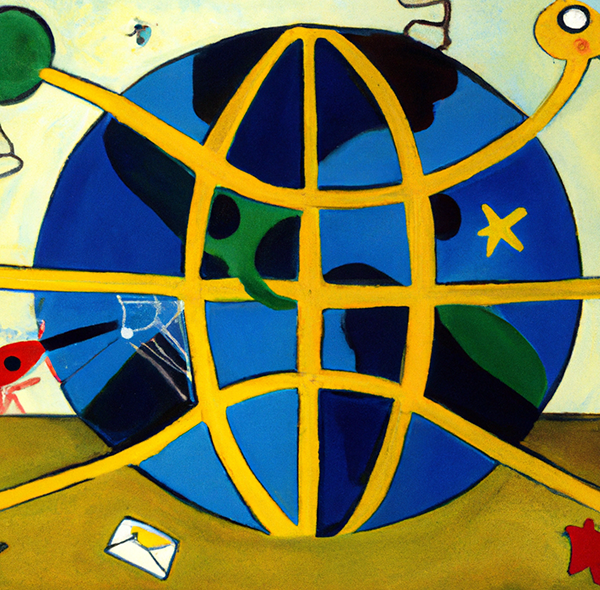
Christmas Trips
For anyone interested in exploring some of the odder Christmas traditions around the world, Atlas Obscurarounds up a few. For example, there is the Ndocciata, a fire ritual that takes place every December in Agnone, Italy, in which
hundreds of people carry 10-foot-tall torches, bearing anywhere between one and 26 fires. It’s a symbolic ritual to rid themselves of evil, lay the groundwork for an auspicious year, and welcome the days getting longer again.
In Nancy, France, the “Christmas Cannibal” is celebrated on St. Nicholas Day:
St. Nicholas Day is celebrated across many European countries on December 6 or the weekend following it. Each evening in Nancy from late November till early January, a lights display projects a story onto the opulent façade of the Hôtel de Ville. The expectant crowd watches as three children knock on the door of a local butcher, only to be chopped up into little pieces and left to cure in a salting pot. Falling snowflakes are replaced with chunks of veal.
How festive! But why, you may ask…
Often throughout Europe, St. Nicholas is said to be accompanied by an evil nemesis designed to frighten children into good behavior. Germany has Hans Trapp, Holland has Zwarte Piet, and Austria is best known for the Krampus, a horned beast that charges the crowd with threatening roars.
Actually, that’s not a bad idea.
Myrrhmyrrhing
We all know that, in the Gospel of Matthew’s account of the Nativity story, the Magi (aka the “wise men”—although “astrologers” is believed to be the more accurate term—and Matthew never says how many of them there were, though “three” has been assumed thanks to the number of gifts bestowed) present the Baby Jesus with gold, frankincense, and myrrh. Gold is easy enough to figure out, but what are frankincense and myrrh? And why give them to an infant? Mental Floss is on the scent.
In the typical Christmastime narrative of Jesus Christ’s birth, he’s born in a manger and visited by three wise men.
We’ll stop right there, as they conflate the two Nativity accounts in the New Testament—Matthew and Luke—which differ in the details, although are not necessarily mutually exclusive in some respects. Matthew features the Magi and the three gifts, but not the manger (in Matthew, Joseph and Mary lived in Bethlehem, as was foretold in Micah 5:1). The Magi first visited King Herod to get directions, which caused some trouble. Luke, on the other hand, makes no mention of the Magi or the gifts, but does have Jesus born in a manger (literally a “feeding trough for animals,” but “Away in a Feeding Trough” would not make for a very nice Christmas carol) with the shepherds and animals watching, as Joseph and Mary were visiting Bethlehem (the city of Joseph’s ancestor David) so Joseph could participate in the census. Anyway, we continue…
They’re sometimes referred to as kings from the East or the Orient, and sometimes as Magi, and they come bearing gifts of gold, frankincense, and myrrh.
…Frankincense and myrrh are the dried sap of trees, also known as resin. Frankincense comes from the deciduous trees of the genus Boswellia, and myrrh from some species in the genus Commiphora, all of which are found on the Horn of Africa and the coastal countries of the Arabian Peninsula.
Perfect for an infant. Well, actually, they could be.
Both resins have traditionally been used as incense and medicine. Frankincense has a woody, fruity smell that is activated when it’s burned; it perfumed ancient Roman homes, archaic Egyptian rituals, and modern Catholic masses. In antiquity, physicians used frankincense to treat ailments ranging from poisoning to diarrhea to leprosy. In some Asian traditional medicines it’s a treatment for indigestion and relieving inflammation.
Myrrh, meanwhile, has a medicinal, somewhat bitter smell when it’s burned. It is an astringent (a substance that causes tissues to constrict), so it was often used to dress wounds. Today, it’s still used to prevent and treat gum disease, and it sometimes shows up in toothpastes and mouthwashes.
Mental Floss leaves us hanging as to why the Magi brought those particular gifts, but frankincense and gold were prescribed gifts in Isaiah 60.6 and myrrh and frankincense are mentioned in Song of Solomon 3.6. So, the stuff was around…
Let Us Spray
One variety of window graphics we typically overlook are those made using “snow spray,” which you occasionally see on retail windows. Via Laughing Squid, Tom Baker (not the Fourth Doctor) makes intricate and quite lovely window illustrations using snow spray and a scraping tool.
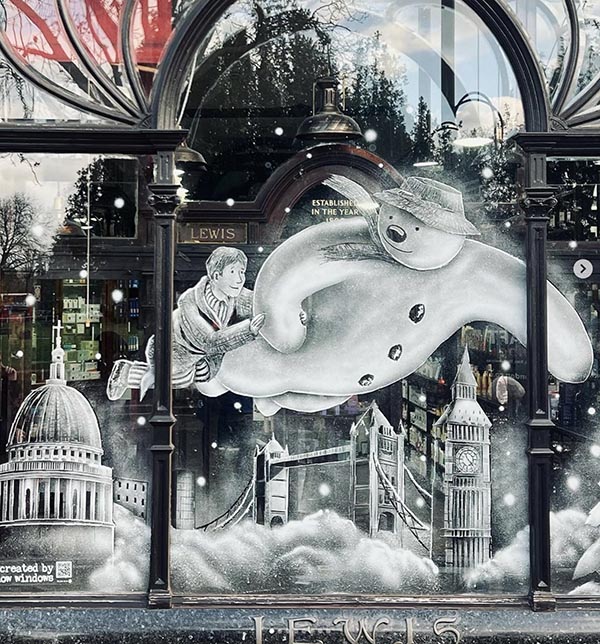
See more on Instagram.
Snowed Under
Speaking of snow, here’s something you may never have wondered: what is the etymology of the word “blizzard”? It’s actually not as simple as you may not ever have thought. Says The New York Times:
On March 7, 1881, The New York Times printed an account that had appeared days earlier in The Daily Republican, a Milwaukee newspaper. A debate had been circulating among publications about the “first use of the word blizzard,” as it applied to snowstorms. Looking for answers, a journalist sent a note to a Milwaukee resident who had lived on the northwestern frontier “when a Minnesota blizzard meant death” to settlers.
Now it just means “flight delays.” Anyway…
The resident said a local man known as Lightning Ellis “originated” the word; “blizzard” was subsequently applied to severe snowstorms in the region in the 1860s. Legend goes that its first newspaper appearance came in 1870 via The Northern Vindicator, a paper in Estherville, Iowa.
However, the word is much older and started with a much different meaning.
Before it was used to describe the weather event, “blizzard” meant a hit or shot. In 1829, the Virginia Literary Museum defined “blizzard” as “a violent blow.” The frontiersman Davy Crockett used it at least once in his 1834 autobiography: “I saw two more bucks, very large fellows too. I took a blizzard at one of them.” Some etymologists believe “blizzard” originated from the German “blitz,” meaning “lightning.”
The wintry meaning hit with full force in 1880–81, which was a particularly bad winter, and took off from there.
In March 1888, after it caught on overseas, The Times wrote that “blizzard” was an “American term for an American storm.” That month, one of the worst blizzards in U.S. history pummeled the East Coast. A Times article with the headline “In a Blizzard’s Grasp” documented the event. Over 400 people died.
And from there, “blizzard” has also come to mean “an overwhelming amount of something,” such as a “blizzard of spam messages” or a “blizzard of requests to take our fall survey.”
And the National Weather Service has strict rules governing what is considered a blizzard: “a snowstorm becomes a blizzard only if it sustains winds of above 35 miles per hour and reduces visibility to less than a quarter-mile for at least three hours.”
Rotten Tomato
Well, to coin a phrase, all’s well that ends well. The International Space Station astronauts have found a tomato that was lost for eight months.
The 1-inch-wide (2.5 centimeters) Red Robin dwarf tomato was a part of the final harvest for the Veg-05 experiment that [astronaut Frank] Rubio himself had tended through some growing pains.
Each ISS astronaut received samples of the tomatoes after the March 29, 2023 harvest, but Rubio's share — stored in a Ziploc bag — floated away before he could take a bite.
Still, he was later accused of eating it and, now that it has been found, he has been vindicated. Our first thought was, how do you lose something on the ISS? But it turns out it’s much bigger than we thought.
the ISS is larger than a six-bedroom house, and, in microgravity, things can easily float away to unexpected corners. NASA’s procedure is usually to check vent intakes, but in a station crowded with 25 years of stuff, it’s easy to lose track of individual items.
… “The reality of the problem, you know — the humidity up there is like 17%. It's probably desiccated to the point where you couldn’t tell what it was, and somebody just threw away the bag,” Rubio added, laughing. “Hopefully somebody will find it someday: a little, shriveled thing.”
Desk Jockeys
When it comes to ergonomics, we could learn a few things from the old pre-printing-press monks who literally hand-copied entire books and other documents. Via Core 77, it seems that the desk wasn’t invented until the invention of paper and writing (makes sense…) and the first visual evidence for the advent of desks comes from13th-century European monasteries.

Although depicting Dominican friar Vincent of Beauvais circa 1220, the illustration itself was made around 1480—and there are some possibly anachronistic elements in it.
For instance, the single gooseneck leg, apparently fabricated out of tubular metal, doesn’t seem likely.
Still:
other elements of the “desk” do appear in other depictions from the era, and these features reveal that their designers/fabricators were ergonomics-minded. The writing surface is slanted, like drafting tables would be half a millennia later, placing the paper within easy reach and perpendicular to the scribe's line of sight. The two red cords hanging off of the back are bookmarks (there’s two because these desks would often have two books side-by-side, one being the source material, the second being a copy produced by the scribe). The little hidey-hole on the side was used to stash smaller scrolls and, I guess, a tomato.
Ah, so that’s where the ISS tomato got to!
That desk design is great for bound books, but what about scrolls? There was a desk for that…
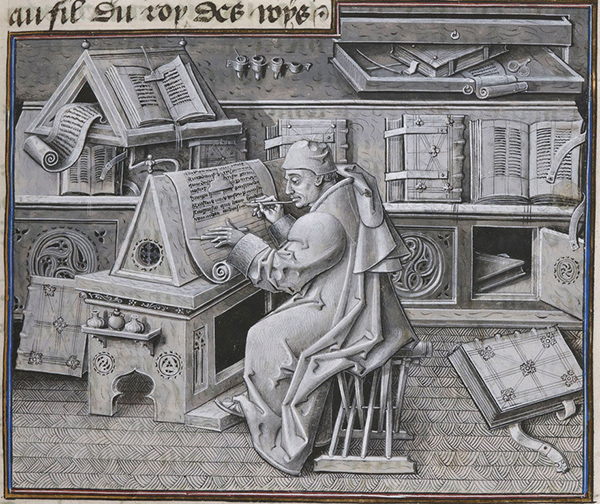
The A-shape is form-follows-function, allowing a scribe to advance a scroll over the top of it, with some support on the back side offered by the tilted surface.
Note the upper unit—this is something like a stacked-dual-monitor set-up used by office workers today. The upper unit probably held the source book or scroll that the scribe copied from.
Believe it or not, these kinds of desks are still made.
The rooms where monks would perform writing work were called scriptoriums. Today there are still people making these scriptorium desks—but not in the way you'd think. These medieval furniture designs have captured the imagination of gamers, and thus you can find both miniatures and 3D-modeled versions…available for sale online.
Wooden It Be Nice
Forget transparent aluminum. Apparently, transparent wood is where it’s at. From Knowable magazine:
Thirty years ago, a botanist in Germany had a simple wish: to see the inner workings of woody plants without dissecting them. By bleaching away the pigments in plant cells, Siegfried Fink managed to create transparent wood, and he published his technique in a niche wood technology journal. The 1992 paper remained the last word on see-through wood for more than a decade, until a researcher named Lars Berglund stumbled across it.
Berglund, a materials scientist, was looking for an alternative to transparent plastic, and has been inspired by Fink’s work, as have others.
Now, after years of experiments, the research of these groups is starting to bear fruit. Transparent wood could soon find uses in super-strong screens for smartphones; in soft, glowing light fixtures; and even as structural features, such as color-changing windows.
“I truly believe this material has a promising future,” says Qiliang Fu, a wood nanotechnologist at Nanjing Forestry University in China who worked in Berglund’s lab as a graduate student.
“Wood nanotechnologist.” Niche work if you can get it…
Wood is made up of countless little vertical channels, like a tight bundle of straws bound together with glue. These tube-shaped cells transport water and nutrients throughout a tree, and when the tree is harvested and the moisture evaporates, pockets of air are left behind. To create see-through wood, scientists first need to modify or get rid of the glue, called lignin, that holds the cell bundles together and provides trunks and branches with most of their earthy brown hues. After bleaching lignin’s color away or otherwise removing it, a milky-white skeleton of hollow cells remains.
This skeleton is still opaque, because the cell walls bend light to a different degree than the air in the cell pockets does — a value called a refractive index. Filling the air pockets with a substance like epoxy resin that bends light to a similar degree to the cell walls renders the wood transparent.

And for those who have ever broken their iPhone screens, transparent wood has (ahem) clear advantages:
In tests measuring how easily materials fracture or break under pressure, transparent wood came out around three times stronger than transparent plastics like Plexiglass and about 10 times tougher than glass.
Just think: someday people may start referring to their “dead tree phone,” to the delight of the paper industry.
Oh, and by the way, since Star Trek IV, transparent aluminum has become a real thing. We suspect the patent is not in Scotty’s name.
Graphene Gets on Board
Was it a good week for graphene news? It’s always a good week for graphene news! Graphene-based corrugated board. From (who else?) Graphene-Info:
Italy-based Kemind previously reported the development of new graphene-enhanced glue concepts that have been applied to its corrugating production process. It was said that the new glue increases production efficiency, reduces costs and improves quality for several of Kemind's corrugated board products. Now, Kemind and 2DFab (which supplies the graphene materials for the project) have updated their satisfaction with the project, stating that Kemigraph® B has been in commercial for several years, and Kemind is continuously buying graphene from 2DFab.
AI-Yi-Yi, Part the Infinity: AI SI
We’ll probably be seeing a lot more stories like this. Via Boing Boing:
Last month, Sports Illustrated removed various articles after the authors were exposed as AI-generated personas and whose text was seemingly AI-generated itself—it was hard to be certain, because the material turned out to be sourced to a content farm whose excuses and assertions Sports Illustrated could only weakly repeat.
And now SI’s CEO has been fired:
A spokesperson for The Arena Group declined to go into further detail to explain the ouster of Ross Levinsohn, who served as chief executive for three years. But the move came after an embarrassing debacle in which Sports Illustrated was caught publishing stories with fake author names and profile photos generated by artificial intelligence.
Levinsohn was replaced, effective immediately, by interim chief executive Manoj Bhargava, the 5-Hour Energy founder who owns a majority stake in The Arena Group, said Vince Bodiford, a spokesperson for Bhargava.
“The 5-Hour Energy founder”… OK.
Have no fear (or hope, depending…), Around the Web is not even remotely robot-written. Even AI isn’t this bad!
What Are You Here After?
Speaking AI, now we’re getting into Black Mirror territory. Says The New York Times:
Some people are turning to A.I. technology as a way to commune with the dead,
Or perhaps former Sports Illustrated CEOs.
but its use as part of the mourning process has raised ethical questions while leaving some who have experimented with it unsettled.
No doubt.
HereAfter AI was introduced in 2019, two years after the debut of StoryFile, which produces interactive videos in which subjects appear to make eye contact, breathe and blink as they respond to questions. Both generate answers from responses users gave to prompts like “Tell me about your childhood” and “What’s the greatest challenge you faced?”
Then again, this is not so surprising.
“Whenever there is a new form of technology, there is always this urge to use it to contact the dead,” Mr. Sample said. He noted Thomas Edison’s failed attempt to invent a “spirit phone.”
And of course there were a couple of Twilight Zone episodes in which the dead reached out and touched someone via phone, although since the advent of Caller ID the twist would be a bit spoiled if the callee could immediately see “dead fiancé” or “deceased grandma” on the screen.
Cyber Truckin’
Whilst we are not especially automotive-minded here in the AtW bunker, we do understand the occasional utility of a pickup truck. And while we know many people who love their Teslas (Teslae?), the company’s foray into pickup trucks—the Cyber truck—is more than a bit…amusing.

Barry Ritholtz of The Big Picture says:
At a car event earlier this year, I spoke with (full-sized traditional) pick-up truck owners, one of whom called the Tesla Cyber truck a “Clown Car.” I think it looks more like it came out of a video game, but that’s my view. My guess is he won’t be a buyer.
Some of you may remember the old arcade game Battle Zone:
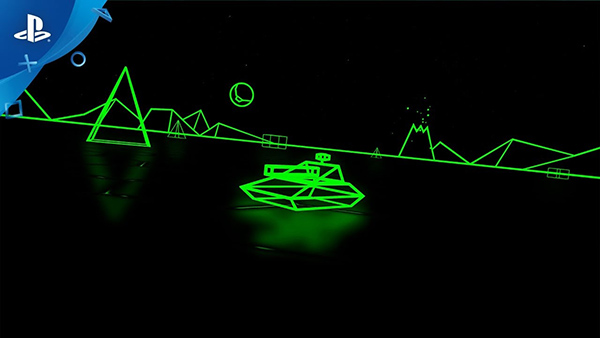
Reviews of the Cyber truck are starting to some out, but The Byte seized on one particular feature: the giant windshield and the seemingly less-than-up-to-the-task windshield wiper:
The specs alone are baffling. It's just under four feet long, and as Carwow's Mat Watson found out firsthand in a recent video, the end is wiggly. Just under a minute into the video, Watson picks up the wiper, revealing that the tip of the wiper blade lifelessly droops down.
Official pictures shared by the EV maker confirm that the wiper is only able to reach a small portion of the glass, meaning that the passenger side will likely remain dirty while on the road.
One wonders what a replacement blade will cost…
We’d Rather Call it Don’t-Ritos
Do you like Doritos? Booze? If so, then good, if not gross, news. Says Food & Wine:
In a most unconventional crossover, the iconic tortilla chip brand has partnered with Empirical Spirits to release an 84-proof clear liquor that actually smells and tastes like the real thing, minus the signature crunch — thankfully. Which is to say, it’s unlike any alcohol you’ve ever smelled or tasted before. And we don’t mean that in a bad way.
Really?
Indeed, one sniff of the spirit is enough to reveal its anchor ingredient. The bouquet is brimming with the unmistakable tang of cheese dust. But in the sip, it’s all about cornier elements. It leaves your palate with a drying note, akin to what accumulates on your tongue after you’ve crushed a sizable bag of corn chips. In other words, it’s maybe more Fritos than Doritos.

“My goal was to recreate the entire experience of opening a bag of Doritos, getting that signature aroma, followed by its flavor dance across the palate with its unmistakable savory, cheesy, and umami notes,” adds Williams.
The describe it as rather like nacho cheese-flavored vodka.
The limited edition bottle of Empirical x Doritos Nacho Cheese Spirit is set to retail at $65 — nearly twice the average sum of super premium vodkas. The ability to show up at a Super Bowl party offering shots of Doritos, however, is surely priceless.
Is it? Is it really?
We are out for the holidays—from all of us at WhatTheyThink, have a great holiday season and we’ll see you in the New Year!
This Week in Printing, Publishing, and Media History
December 11
1918: Russian novelist, historian, short story writer, and Nobel Prize laureate Aleksandr Solzhenitsyn born.
1972: Apollo 17 becomes the sixth and final Apollo mission to land on the Moon.
December 12
1821: French novelist Gustave Flaubert born.
1901: Guglielmo Marconi receives the first transatlantic radio signal (the letter "S" [***] in Morse Code), at Signal Hill in St John’s, Newfoundland.
1999: American novelist, short story writer, and playwright Joseph Heller dies (b. 1923).
2020: English author John le Carré dies (b. 1931).
December 13
1962: NASA launches Relay 1, the first active repeater communications satellite in orbit.
1972: Apollo 17 astronauts Eugene Cernan and Harrison Schmitt become the last humans to set foot on the Moon.
December 14
1902: The Commercial Pacific Cable Company lays the first Pacific telegraph cable, from San Francisco to Honolulu.
1903: The Wright brothers make their first attempt to fly with the Wright Flyer at Kitty Hawk, N.C.
1948: Thomas T. Goldsmith Jr. and Estle Ray Mann are granted a patent for their cathode-ray tube amusement device, the earliest known interactive electronic game.
1972: Apollo astronaut Eugene Cernan is the last person to walk on the moon.
December 15
1791: The United States Bill of Rights becomes law after it is ratified by the Virginia General Assembly.
1939: Gone with the Wind (the highest inflation-adjusted grossing film) receives its premiere at Loew's Grand Theatre in Atlanta, Ga.
December 16
1775: English novelist Jane Austen born.
1901: Beatrix Potter privately publishes The Tale of Peter Rabbit. It goes on to sell over 45 million copies worldwide.
1917: British science fiction writer Arthur C. Clarke born.
1928: American science fiction writer Philip K. Dick born.
December 17
1790: The Aztec calendar stone is discovered at El Zócalo, Mexico City.
1892: The first issue of Vogue is published.
1903: The Wright brothers make the first controlled powered, heavier-than-air flight in the Wright Flyer at Kitty Hawk, N.C.
1937: American novelist John Kennedy Toole (A Confederacy of Dunces) born.
1989: The Simpsons first premieres on television with the episode “Simpsons Roasting on an Open Fire.”
December 18
1892: Premiere performance of The Nutcracker by Pyotr Ilyich Tchaikovsky in Saint Petersburg, Russia.
1958: Project SCORE, the world’s first communications satellite, is launched.
December 19
1776: Thomas Paine publishes one of a series of pamphlets in The Pennsylvania Journal entitled “The American Crisis.”
1843: The novella A Christmas Carol by Charles Dickens is first published. Bah!
1932: BBC World Service begins broadcasting as the BBC Empire Service.
December 20
1948: English keyboard player and producer Alan Parsons born.
1946: The film It’s a Wonderful Life is first released in New York City.
1946: Israeli-English magician, “psychic,” and spoon-mangler Uri Geller born.
1971: The international aid organization Doctors Without Borders is founded by Bernard Kouchner and a group of journalists in Paris, France.
December 21
1879: World premiere of Henrik Ibsen’s A Doll’s House at the Royal Theatre in Copenhagen, Denmark.
1913: Arthur Wynne’s “word-cross,” the first crossword puzzle, is published in the New York World. The Oreo cookie had been introduced a year earlier. Coincidence? (See if we can spot the cruciverbalists out there.)
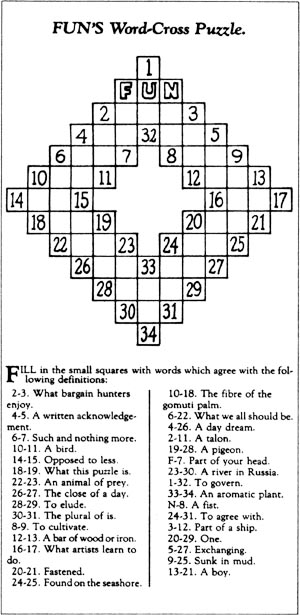
1937: Snow White and the Seven Dwarfs, the world’s first full-length animated feature, premieres at the Carthay Circle Theatre.
1940: The late, great American composer, singer-songwriter, guitarist, and producer Frank Zappa born. Watch out where the huskies go.
December 22
1808: Ludwig van Beethoven conducts and performs in concert at the Theater an der Wien, Vienna, with the premiere of his Fifth Symphony, Sixth Symphony, Fourth Piano Concerto (performed by Beethoven himself) and Choral Fantasy (with Beethoven at the piano).
1880: English novelist and poet George Eliot dies (b. 1819).
1891: Asteroid 323 Brucia becomes the first asteroid discovered using photography.
1936: Irish science historian and author James Burke (Connections) born.
2001: Richard Reid attempts to destroy a passenger airliner by igniting explosives hidden in his shoes aboard American Airlines Flight 63; as a result, air travelers passing through security will have to take off their #$^&@! shoes in perpetuity. So thanks for that, Mr. Reid.
December 23
1815: The novel Emma by Jane Austen is first published.
1893: The opera Hansel and Gretel by Engelbert Humperdinck is first performed.
1913: The Federal Reserve Act is signed into law by President Woodrow Wilson, creating the Federal Reserve System.
1947: The transistor is first demonstrated at Bell Laboratories.
December 24
1818: The first performance of “Silent Night” takes place in the church of St. Nikolaus in Oberndorf, Austria.
1822: English poet and critic Matthew Arnold born.
1851: The Library of Congress in Washington, D.C., burns.
1863: English author and poet William Makepeace Thackeray dies (b. 1811).
1871: The opera Aida premieres in Cairo, Egypt.
1906: Reginald Fessenden transmits the first radio broadcast consisting of a poetry reading, a violin solo, and a speech.
1968: The crew of Apollo 8 enters into orbit around the Moon, becoming the first humans to do so. They performed 10 lunar orbits and broadcast live TV pictures.
December 25
336: First documented Christmas celebration in Rome.
1642: English physicist and mathematician Isaac Newton born.
1758: Halley’s Comet is sighted by Johann Georg Palitzsch, confirming Edmund Halley’s prediction of its passage. This was the first passage of a comet predicted ahead of time.
1815: The Handel and Haydn Society, oldest continually performing arts organization in the United States, gives its first performance.
1890: American publisher, co-founder of Reader’s Digest Lila Bell Wallace born.
1924: American screenwriter and producer Rod Serling born.
1938: Czech author and playwright Karel ?apek dies (b. 1890).
2004: The Cassini orbiter releases Huygens probe which successfully lands on Saturn’s moon Titan on January 14, 2005.
December 26
1791: English mathematician and engineer, inventor of the Difference engine Charles Babbage born.
1871: Thespis, the first Gilbert and Sullivan collaboration, debuts. It does modestly well, but the two would not collaborate again for four years and the score has been lost.
1931: American librarian and educator, creator of the Dewey Decimal Classification Melvil Dewey dies (b. 1851).
1963: The Beatles’ “I Want to Hold Your Hand” and “I Saw Her Standing There” are released in the United States, marking the beginning of Beatlemania on an international level.
1966: The first Kwanzaa is celebrated by Maulana Karenga, the chair of Black Studies at California State University, Long Beach.
December 27
1831: Charles Darwin embarks on his journey aboard HMS Beagle, during which he will begin to formulate his theory of evolution.
1845: Journalist John L. O'Sullivan, writing in his newspaper the New York Morning News, argues that the United States had the right to claim the entire Oregon Country “by the right of our manifest destiny.”
1927: Kern and Hammerstein’s musical play Show Boat, considered to be the first true American musical play, opens at the Ziegfeld Theatre on Broadway.
1932: Radio City Music Hall, “Showplace of the Nation,” opens in New York City.
1941: English singer-songwriter and keyboard player Mike Pinder born.
1968: Apollo 8 splashes down in the Pacific Ocean, ending the first orbital manned mission to the Moon.
December 28
1895: The Lumière brothers perform for their first paying audience at the Grand Cafe in Boulevard des Capucines.
1895: Wilhelm Röntgen publishes a paper detailing his discovery of a new type of radiation, which later will be known as x-rays.
1902: The Syracuse Athletic Club defeated the New York Philadelphians, 5–0, in the first indoor professional football game, which was held at Madison Square Garden.
1922: American publisher and producer Stan Lee born.
1945: American novelist and journalist Theodore Dreiser dies (b. 1871).
1958: “Greatest Game Ever Played”: Baltimore Colts defeat the New York Giants in the first ever National Football League sudden death overtime game at New York’s Yankee Stadium.
1973: The United States Endangered Species Act is signed into law by Pres. Richard Nixon.
December 29
1170: Thomas Becket, Archbishop of Canterbury, is assassinated inside Canterbury Cathedral by followers of King Henry II; he subsequently becomes a saint and martyr in the Anglican Communion and the Catholic Church. Chaucer’s The Canterbury Tales are set during a pilgrimage to his shrine.
1766: Scottish chemist and the inventor of waterproof fabric Charles Macintosh born.
1851: The first American YMCA opens in Boston, Mass.
1916: A Portrait of the Artist as a Young Man, the first novel by James Joyce, was first published as a book by an American publishing house B. W. Huebschis after it had been serialized in The Egoist (1914–15).
1926: Austrian poet and author Rainer Maria Rilke dies (b. 1875).
1936: American actress and producer Mary Tyler Moore born.
1941: English singer-songwriter and flute player Ray Thomas born.
1949: KC2XAK of Bridgeport, Connecticut becomes the first Ultra high frequency (UHF) television station to operate a daily schedule.
1989: Czech writer, philosopher, and dissident Václav Havel is elected the first post-communist President of Czechoslovakia.
December 30
1865: English author and poet, Nobel Prize laureate Rudyard Kipling born.
1896: Canadian ice hockey player Ernie McLea scores the first hat-trick in Stanley Cup play, and the Cup-winning goal as the Montreal Victorias defeat the Winnipeg Victorias 6–5.
1927: The Ginza Line, the first subway line in Asia, opens in Tokyo, Japan.
1983: American computer programmer and businessman, co-founder of Instagram Kevin Systrom born.
December 31
1759: Arthur Guinness signs a 9,000 year lease at £45 per annum and starts brewing Guinness.
1790: Efimeris, the oldest Greek newspaper of which issues have survived till today, is published for the first time.
1878: Karl Benz, working in Mannheim, Germany, filed for a patent on his first reliable two-stroke gas engine, and he was granted the patent in 1879.
1879: Thomas Edison demonstrates incandescent lighting to the public for the first time, in Menlo Park, New Jersey.
1907: The first New Year’s Eve celebration is held in Times Square (then known as Longacre Square) in Manhattan. No word if Dick Clark was hosting.
1955: General Motors becomes the first U.S. corporation to make over US$1 billion in a year.
1956: The Romanian Television network begins its first broadcast in Bucharest.
1959: American singer-songwriter and guitarist Paul Westerberg born.
1961: RTÉ, Ireland’s state broadcaster, launches its first national television service.
1980: Canadian philosopher and theorist Marshall McLuhan dies (b. 1911).
1983: The AT&T Bell System is broken up by the United States Government.
1998: The European Exchange Rate Mechanism freezes the values of the legacy currencies in the Eurozone, and establishes the value of the euro currency.
2019: The World Health Organization was informed of cases of pneumonia with an unknown cause, detected in Wuhan. This later turned out to be COVID-19, the cause of the COVID-19 pandemic.
2020: The World Health Organization's issues its first emergency use validation for a COVID-19 vaccine.










Discussion
Join the discussion Sign In or Become a Member, doing so is simple and free